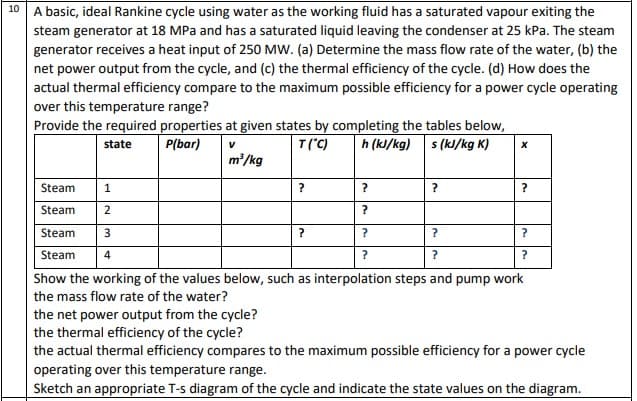A basic, ideal Rankine cycle using water as the working fluid has a saturated vapour exiting the steam generator at 18 MPa and has a saturated liquid leaving the condenser at 25 kPa. The steam generator receives a heat input of 250 MW. (a) Determine the mass flow rate of the water, (b) the net power output from the cycle, and (c) the thermal efficiency of the cycle. (d) How does the actual thermal efficiency compare to the maximum possible efficiency for a power cycle operating over this temperature range? Provide the required properties at given states by completing the tables below, state P(bar) V T("C) h (kJ/kg) s (kJ/kg K) m²/kg Steam Steam 2 Steam 3 Steam 4 1 ? ? ? ? ? ? ? ? ? ? Show the working of the values below, such as interpolation steps and pump work the mass flow rate of the water? ? ? the net power output from the cycle? the thermal efficiency of the cycle? the actual thermal efficiency compares to the maximum possible efficiency for a power cycle operating over this temperature range. Sketch an appropriate T-s diagram of the cycle and indicate the state values on the diagram.
A basic, ideal Rankine cycle using water as the working fluid has a saturated vapour exiting the steam generator at 18 MPa and has a saturated liquid leaving the condenser at 25 kPa. The steam generator receives a heat input of 250 MW. (a) Determine the mass flow rate of the water, (b) the net power output from the cycle, and (c) the thermal efficiency of the cycle. (d) How does the actual thermal efficiency compare to the maximum possible efficiency for a power cycle operating over this temperature range? Provide the required properties at given states by completing the tables below, state P(bar) V T("C) h (kJ/kg) s (kJ/kg K) m²/kg Steam Steam 2 Steam 3 Steam 4 1 ? ? ? ? ? ? ? ? ? ? Show the working of the values below, such as interpolation steps and pump work the mass flow rate of the water? ? ? the net power output from the cycle? the thermal efficiency of the cycle? the actual thermal efficiency compares to the maximum possible efficiency for a power cycle operating over this temperature range. Sketch an appropriate T-s diagram of the cycle and indicate the state values on the diagram.
Elements Of Electromagnetics
7th Edition
ISBN:9780190698614
Author:Sadiku, Matthew N. O.
Publisher:Sadiku, Matthew N. O.
ChapterMA: Math Assessment
Section: Chapter Questions
Problem 1.1MA
Related questions
Question

Transcribed Image Text:10
A basic, ideal Rankine cycle using water as the working fluid has a saturated vapour exiting the
steam generator at 18 MPa and has a saturated liquid leaving the condenser at 25 kPa. The steam
generator receives a heat input of 250 MW. (a) Determine the mass flow rate of the water, (b) the
net power output from the cycle, and (c) the thermal efficiency of the cycle. (d) How does the
actual thermal efficiency compare to the maximum possible efficiency for a power cycle operating
over this temperature range?
Provide the required properties at given states by completing the tables below,
state
P(bar)
V
T (°C)
h (kJ/kg)
s (kJ/kg K)
m³/kg
Steam
1
Steam 2
Steam
3
?
Steam
4
?
Show the working of the values below, such as interpolation steps and pump work
the mass flow rate of the water?
?
?
?
?
?
?
X
?
?
?
?
the net power output from the cycle?
the thermal efficiency of the cycle?
the actual thermal efficiency compares to the maximum possible efficiency for a power cycle
operating over this temperature range.
Sketch an appropriate T-s diagram of the cycle and indicate the state values on the diagram.
Expert Solution
This question has been solved!
Explore an expertly crafted, step-by-step solution for a thorough understanding of key concepts.
Step by step
Solved in 5 steps with 5 images

Knowledge Booster
Learn more about
Need a deep-dive on the concept behind this application? Look no further. Learn more about this topic, mechanical-engineering and related others by exploring similar questions and additional content below.Recommended textbooks for you

Elements Of Electromagnetics
Mechanical Engineering
ISBN:
9780190698614
Author:
Sadiku, Matthew N. O.
Publisher:
Oxford University Press

Mechanics of Materials (10th Edition)
Mechanical Engineering
ISBN:
9780134319650
Author:
Russell C. Hibbeler
Publisher:
PEARSON

Thermodynamics: An Engineering Approach
Mechanical Engineering
ISBN:
9781259822674
Author:
Yunus A. Cengel Dr., Michael A. Boles
Publisher:
McGraw-Hill Education

Elements Of Electromagnetics
Mechanical Engineering
ISBN:
9780190698614
Author:
Sadiku, Matthew N. O.
Publisher:
Oxford University Press

Mechanics of Materials (10th Edition)
Mechanical Engineering
ISBN:
9780134319650
Author:
Russell C. Hibbeler
Publisher:
PEARSON

Thermodynamics: An Engineering Approach
Mechanical Engineering
ISBN:
9781259822674
Author:
Yunus A. Cengel Dr., Michael A. Boles
Publisher:
McGraw-Hill Education

Control Systems Engineering
Mechanical Engineering
ISBN:
9781118170519
Author:
Norman S. Nise
Publisher:
WILEY

Mechanics of Materials (MindTap Course List)
Mechanical Engineering
ISBN:
9781337093347
Author:
Barry J. Goodno, James M. Gere
Publisher:
Cengage Learning

Engineering Mechanics: Statics
Mechanical Engineering
ISBN:
9781118807330
Author:
James L. Meriam, L. G. Kraige, J. N. Bolton
Publisher:
WILEY